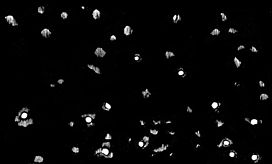Craniology of the Africans.—M. de Quatrefages recently explained to the French Academy of Sciences the results of the researches of M. Hamy on the craniology of the African races. Far from all the negroes of Africa being dolichocephalous (or long-skulled), there exist on the continent diverse populations, forming two distinct groups, which pass in succession from the sub-brachycephalic (moderately short-skulled) to the mesocephalic (medium-skulled) and to the sub-dolichocephalic, and finally to the true dolichocephalic type. In other words, the relation of the transverse diameter to the antero-posterior diameter of the skull goes on progressively diminishing. M. Hamy has also studied the race of the dwarf negroes, and finds that their skulls are quite as much arched as those of the other human races. Their stature nearly approaches that of the Mincopies of the Andaman Islands, but it is superior to that of the Bushmen, whose height often falls to one metre (three feet three inches), sometimes to 1·14 metre (three feet eight and a half inches). This race probably approaches the true brachycephalic type. M. Hamy joins in a single race the Noubas, the Fourahs, the Gallas, the Nyam-Nyams, etc., and attaches to the same group, which is generally Eastern, the Haoussas who live west of Lake Tchad, although a population craniologically distinct is situated between them.
Rats and Lead Pipes.—One of the best foreign authorities on sanitary engineering, Dr. William Eassie, has an interesting letter in a late number of the "Sanitary Record" on the destruction of lead pipes and flashings by rats, mice, and even timber-worms. He relates several cases, either seen by himself or brought to his attention by others, in which lead waste-pipes were perforated with veritable rat-holes, thus admitting not only sewer-gas but the rats themselves into the house. Fig. 1 is reproduced from Dr. Eassie's letter, and represents a piece of two-inch lead pipe a quarter of an inch thick, which wag once a part of the waste-pipe of a sink in a house in London.
Fig. 1.

This pipe terminated in an old brick drain infested with rats. "The rats obtained ingress to the house by way of this pipe, that is certain; and on taking up the floor some hundreds of these animals were destroyed and many missing articles recovered. The marks of their teeth are very plainly exhibited, as may be seen by a glance at the woodcut, which does not exaggerate them in any way." Fig. 2 represents a piece of lead flashing obtained by Dr. Eassie from the roof of an infirmary in the north of England. The woodwork below had been first destroyed by wood-borers, and the light, shaded marks in the cut show
Fig. 2.

where the acid of the destroyed wood had partially eaten away the lead. The white holes are actual perforations to the open air. Other instances of a like character are given, and all go to show that lead, where so exposed, is not a safe plumbing material.
A Musical Valley.—In an essay on "The Singing Valley of Thronecken," Herr H. Reulaux has described an enduring sound like the ringing of bells, which he heard while engaged in a deer-hunt in an elevated wooded valley in the Rhine Province. He had before heard sounds in the valley, re-

